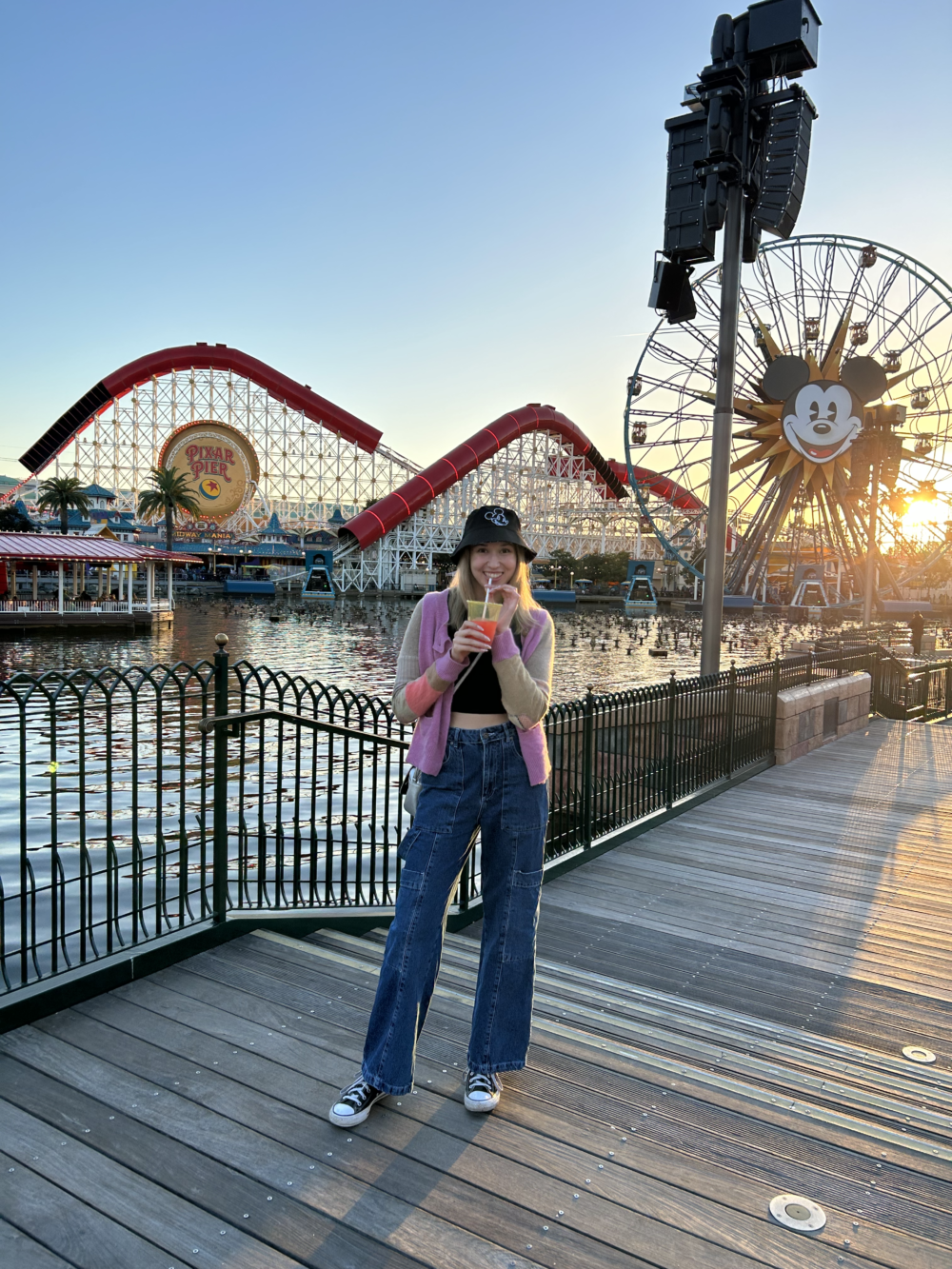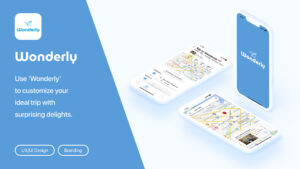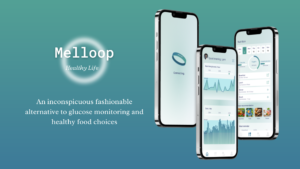Shine
Chelsea Burke
Award Recipient
ECU Health Design Award for Innovation – Honourable Mention
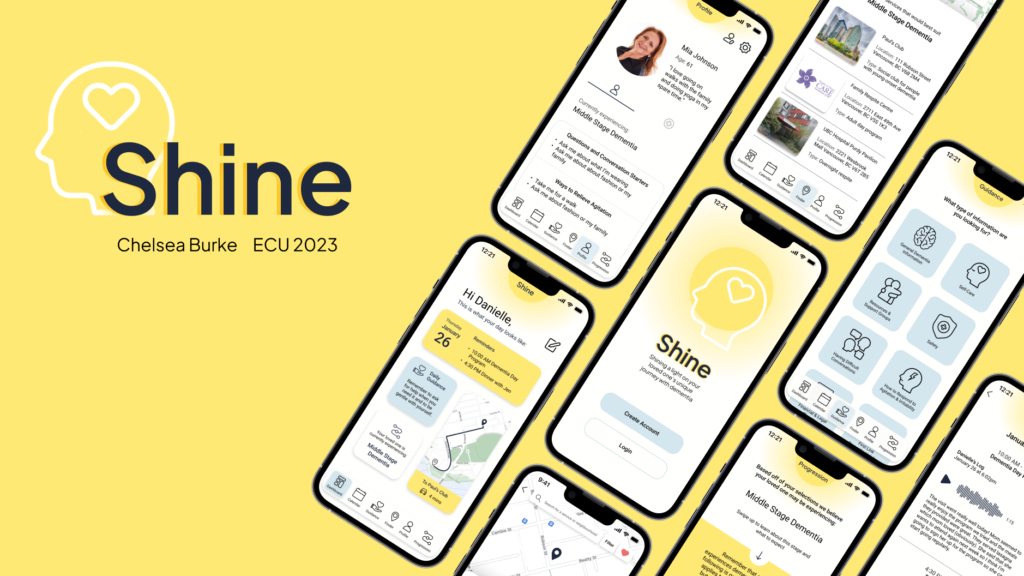
Shine is an app that provides curated dementia and caregiving information, resources, and services to informal caregivers of people living with dementia. A dementia diagnosis affects not only the person who was diagnosed, but their loved ones as well. Through the onboarding and profile questionnaire, Shine determines the needs of the caregiver and the person experiencing dementia, and curates information and resources based off these needs and the stage of dementia being experienced. Becoming a caregiver can be disorienting and stressful, so being able to access trusted knowledge and local resources can provide much needed support and respite. Shine helps to build caregiver confidence and knowledge, allowing caregivers to feel supported and equipped with the tools they need to best navigate their loved one’s journey with dementia. The outcome is a clickable MVP designed in Figma and promo video created using Figma and Adobe Premiere Pro.
Project Details
- My Role: Designer
- Project Length: September 2022 – April 2023
- Tools Used: Pen & paper, Figma, Adobe Premiere Pro, Adobe InDesign, Adobe Photoshop, Microsoft PowerPoint
- Methods Used: Sketching, primary & secondary research, mapping, personas, SWOT analyses, competitive analyses, wireframing, storyboarding, scenarios, clickable prototypes, video prototypes
Why This Project?
I chose to do this project because I have lived experience caring for a family member with dementia. This experience combined with watching other family members become caregivers, is what made me want to design a tool that could help bring comfort and relief to myself and my family members when we needed it most. What my family could’ve greatly benefited from was reliable information, resources, and services about dementia and caregiving that was easily accessible. Many caregivers, including my family, feel lost and overwhelmed when trying to navigate this journey. Personality changes, changing ability levels, safety concerns, new routines, and tough conversations, are just a few of the many new things that caregivers need to navigate. Being able to find resources and services to help with these changes and to organize and keep track of important information, are things that I know would be helpful to many caregivers of loved ones with dementia.
I have also worked with people with lived experience with dementia and their loved ones through other class projects and through my work with the Emily Carr Health Design Lab. Working on these projects was very rewarding, and I enjoyed learning about other people’s experiences with dementia as it varies greatly from person to person. The knowledge and experience I gained from these experiences, as well as my own lived experience, is what I used to help inform and inspire this project.
Problem Space
Dementia is a general term for impaired cognitive functioning that interferes with a person’s daily life and activities. Symptoms can vary widely from person to person, but people with dementia often have difficulties with memory, attention, communication, reasoning, judgement and problem solving, as well as changes in vision. Respite services provide a break for caregivers, and can be provided as in-home care, community adult day services, short term stays in long-term care homes, or in other community settings. These services can be either public or private.
Research Insights
Dementia & Caregiving
Over half a million Canadian’s were reported to be living with dementia in 2020 and that number is predicted to double by 2030. And of these people, about 70% of them receive in-home care provided by family members. The level of care needed increases as the disease progresses, this can lead to increased caregiver stress and anxiety. Additionally, caregivers often feel overwhelmed and emotionally and physically exhausted, and can experience latent grief. This not only affects the caregiver, but can also affect the person with dementia.
What Improves Caregiver Wellbeing?
Tips to manage caregiver stress include knowing what resources are available, finding support, finding time for yourself, becoming an educated caregiver, and taking care of yourself. Regular relief can help to ease stress and fatigue by giving caregivers a break as well as providing practical support. Explaining the factors that contribute to caregiver strain and uncertainty can help with coping. Caregivers often use the internet and social media to obtain information and advice, and mobile apps can also be an effective solution to reduce burden and improve wellbeing.
Opportunity Map
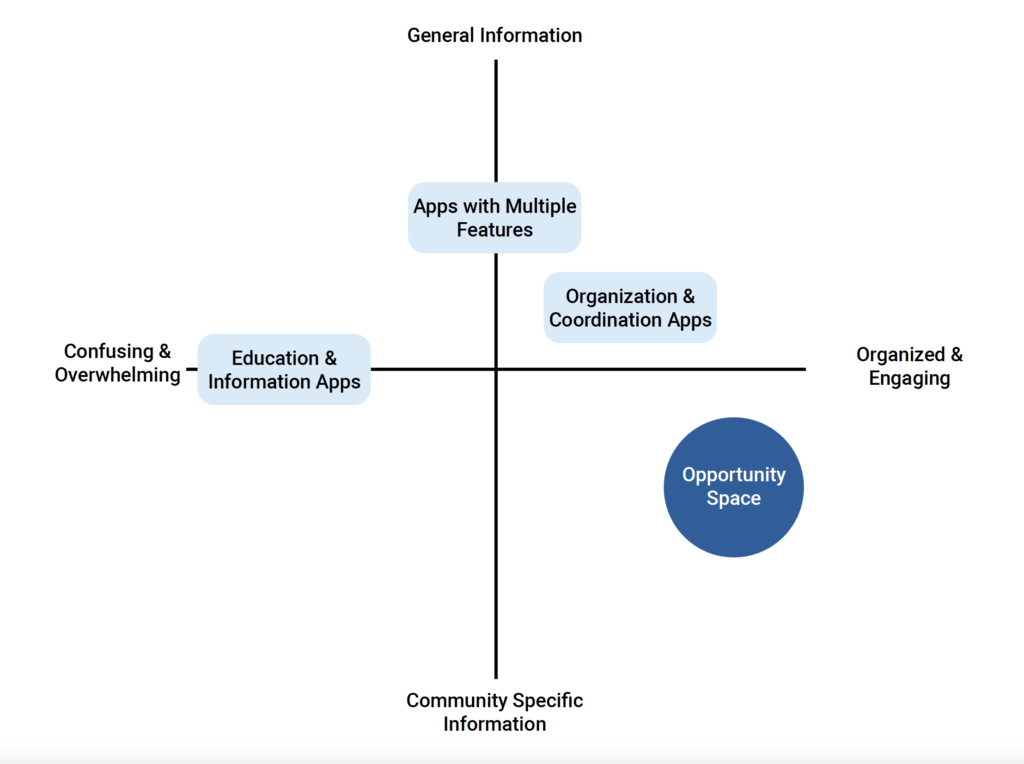
I did a competitive analysis of some of the existing Alzheimer’s and dementia apps. I broke them up into three categories education and information based apps, organization and coordination apps, and apps with multiple caregiver features, and then created a SWOT analysis for each one. Based on my competitive analysis and SWOT analyses, I determined that my opportunity space is designing something that is organized and engaging that includes curated content tailored to the stage of the dementia being experienced, and community specific resources and services with some general information and advice about dementia and caregiving.
Expert Feedback
I spoke to four experts who work and/or have lived experience in the spaces of dementia and aging. I spoke with a nurse researcher who was my mentor for the project (Mariko Sakamoto), a caregiver whose husband lives with dementia (caregiver consultant), and staff from the Burnaby Neighbourhood House and from Paul’s Club. I consulted my mentor and caregiver consultant multiple times throughout this project to get feedback and advice about my prototypes and designs. Burnaby Neighbourhood House runs various programming that could be used as respite during the early stages of dementia, and Paul’s Club is a social and recreational day program for people living with Young Onset Dementia. These are the main insights I took away from speaking with each of them:
Nurse Researcher
- App that lets caregivers know what respite options are available would be beneficial
- Many options available for caregivers, but few know what’s available in their communities
- Different people have different needs
Caregiver
- Content should have positive tone
- Many people take transit to services
- Important to know what training the staff have
Burnaby Neighbourhood House
- Referrals mainly happens through healthcare professionals and word-of-mouth
- HandyDart is often used to transport people to and from the programs
Paul’s Club
- Very few respite services specifically for people with young onset dementia
- Think of outside the box options for respite
- Can’t attend more than one respite service within Vancouver Coastal Health
Why is This Needed?
Based on the insights from my primary and secondary research, these are the reasons why Shine is needed and would benefit caregivers who care for someone living with dementia:
- Reduce anxiety and stress through access to reliable knowledge and resources
- Content and information can be overwhelming to navigate online and often not tailored to caregiver’s current needs
- Give support and create time to run errands and/or do things outside of caregiver role
- No current directory available for all respite services
- Many caregivers find out about services through word of mouth and/or healthcare providers
- Wait time to access publicly funded services can be long, so it is good to know what other service options are available to caregivers
Persona & Scenario
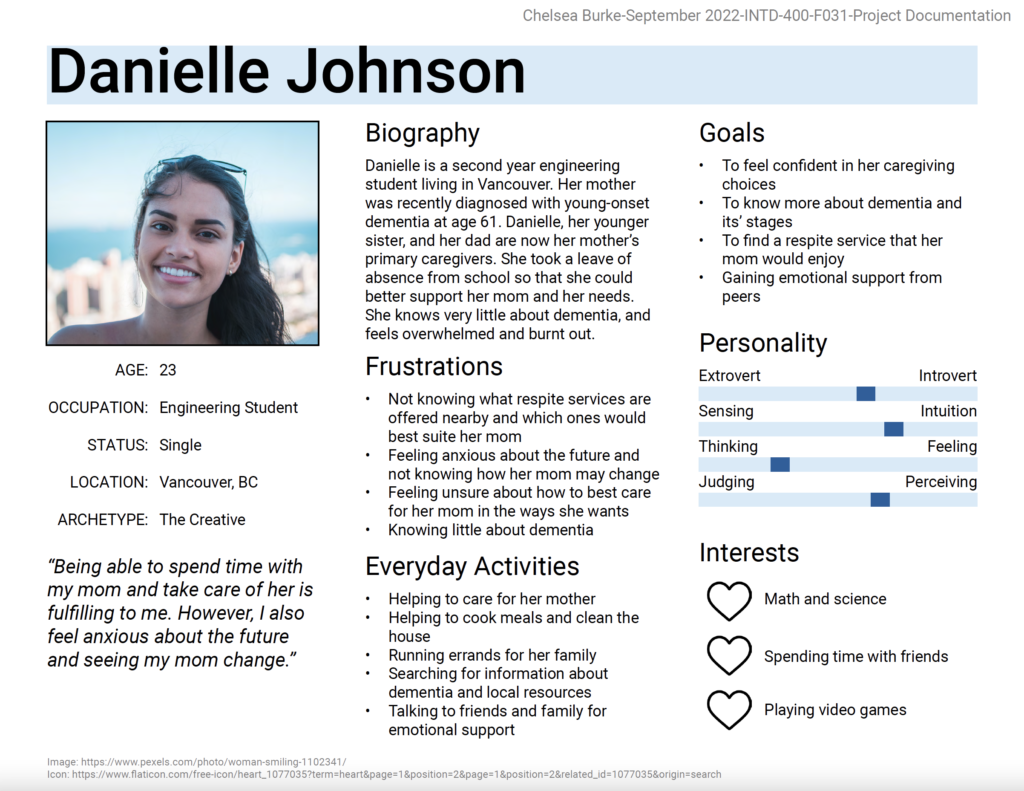
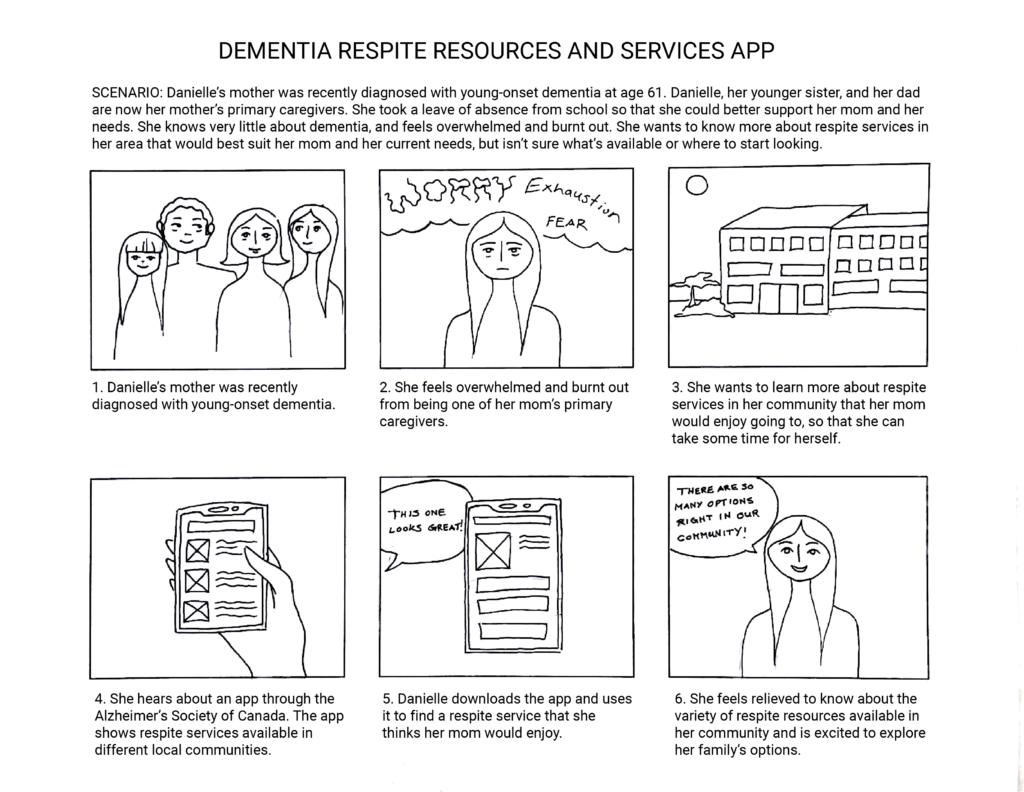
The first image is my persona. Danielle is a second-year engineering student living in Vancouver. Her mother was recently diagnosed with young-onset dementia at age 61. Danielle, her younger sister, and her dad are now her mother’s primary caregivers. She took a leave of absence from school so that she could better support her mom and her needs. She knows very little about dementia, and feels overwhelmed and burnt out.
The second image is my initial scenario, and while my app’s focus shifted slightly, I think it still applies well as this could be one use case for why a caregiver would use Shine. It involves Danielle searching for respite programs that her mom could attend.
Concept Sketch
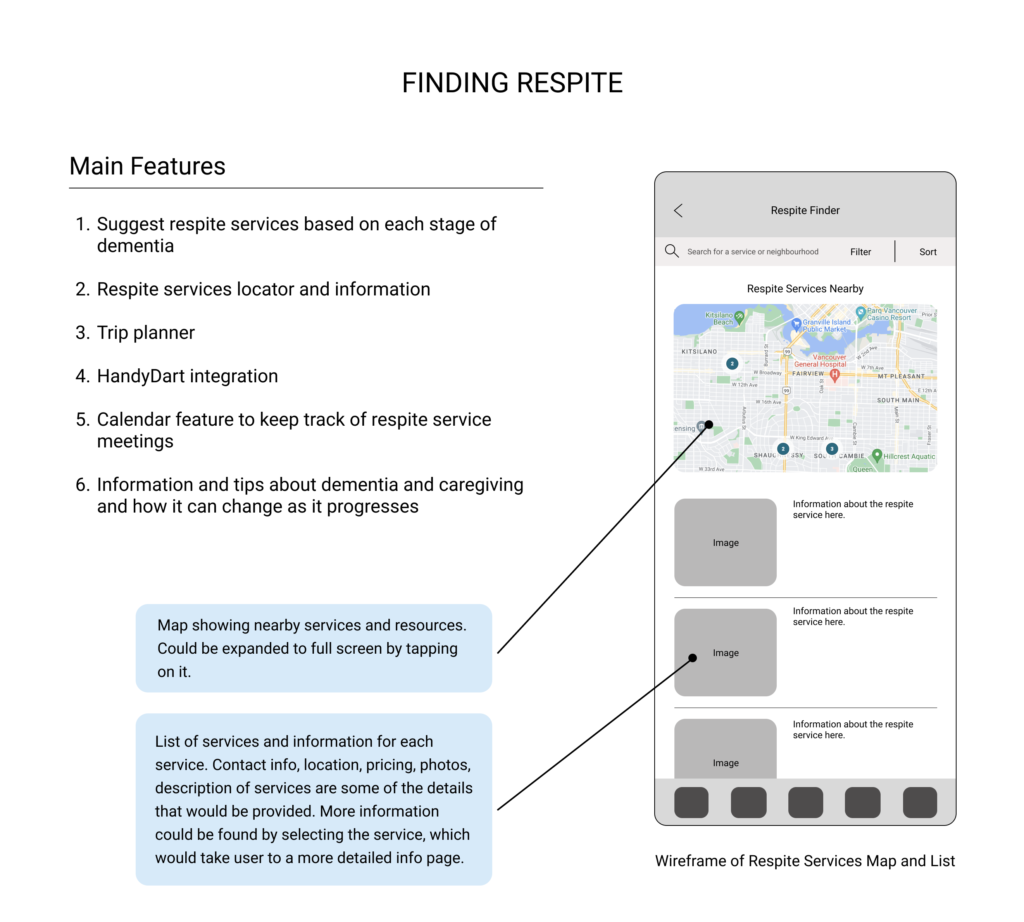
This is an early concept sketch. It includes a more detailed wireframe of the app, as well as a feature list that was ranked (in order from most to least important) by my caregiver consultant. All of these features made it to the final prototype, except for the HandyDart integration, which I had to put to the side due to time constraints.
Prototype I & Feedback
These are some of the main screens of the first prototype. At this stage I was still working with clickable wireframes, and I was planning on designing an app that focused on providing a directory for dementia respite services in the Vancouver area. Since this was the focus, the user flows are related to the respite finder. The main user flows I designed to test with were suggesting respite services based off the stage of dementia being experienced, and the finding detailed information about local services and planning out how to get there.
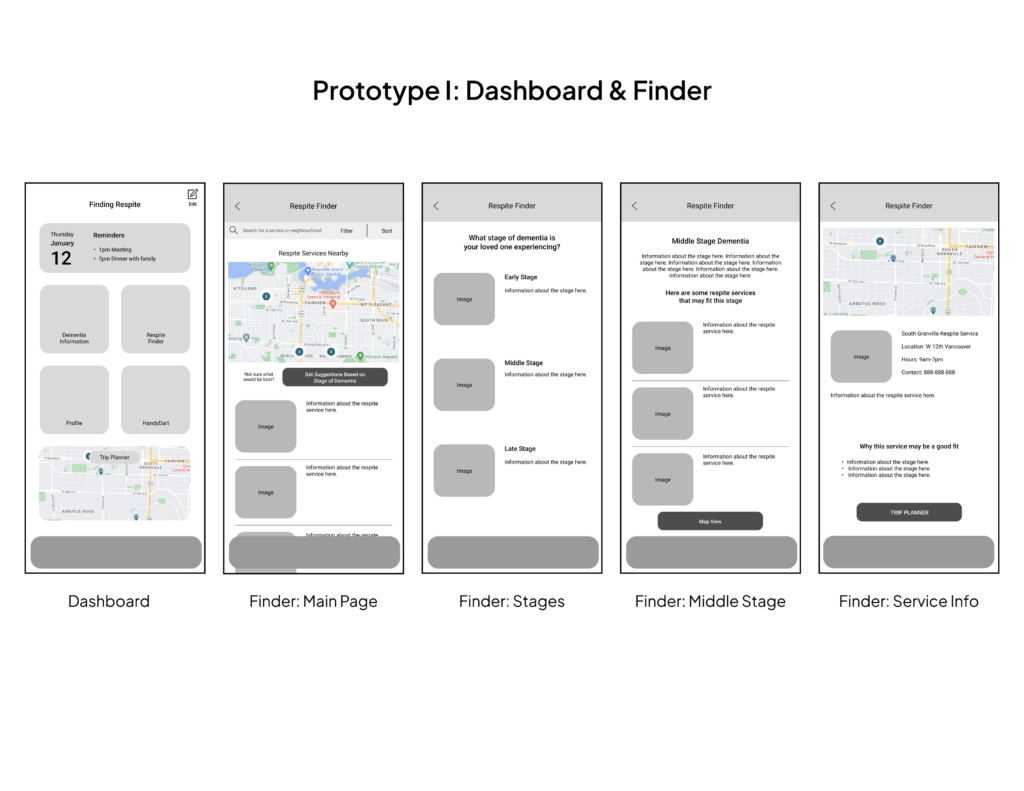
After the first round of user testing, the main feedback I was given was to add a detailed onboarding process that would customize the app for the caregiver’s unique needs. These are the screens I designed for that process. It features a set of questions to help customize the user experience and determine what stage of dementia the person with dementia is experiencing. I also began to build out more features in the app, such as the calendar feature.
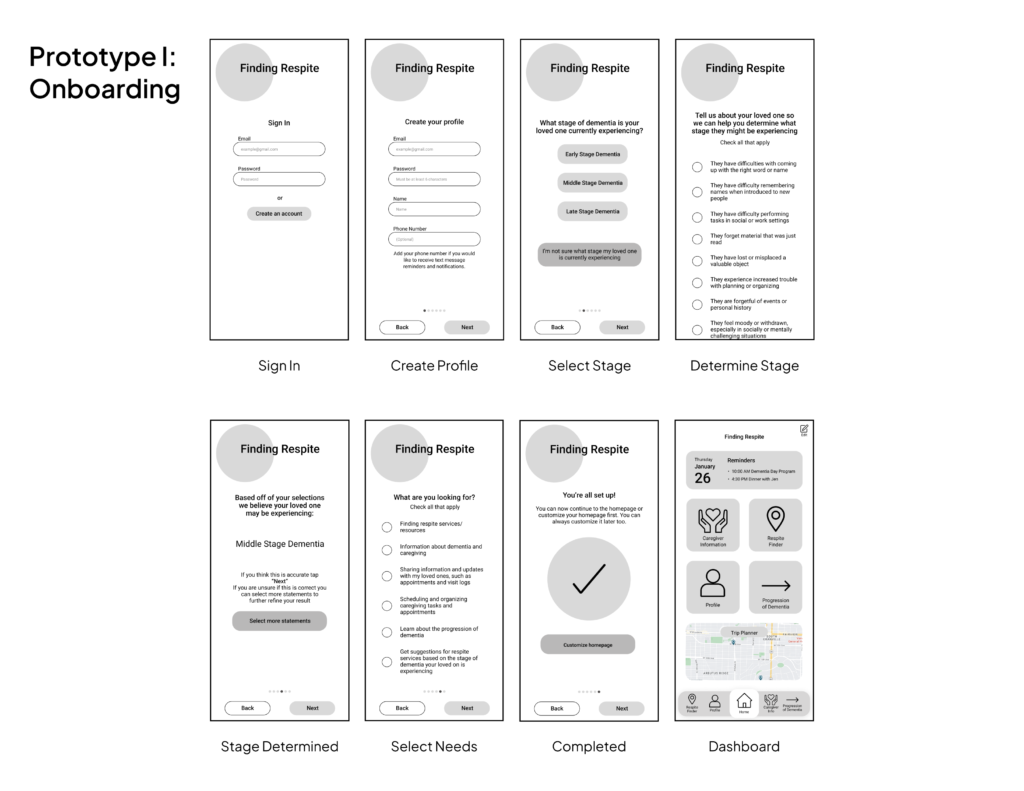
For the second round of testing, I received feedback from my classmates and instructor. The main feedback I received was to add more detailed information to the onboarding process and the stages of dementia, and to adjust some of the icons.
Prototype II & Feedback
These are some of the main screens of the second prototype, which is the first prototype to contain all of Shine’s current features. At this stage I still was focusing on the app’s content and layout, so I had not added much UI design yet.
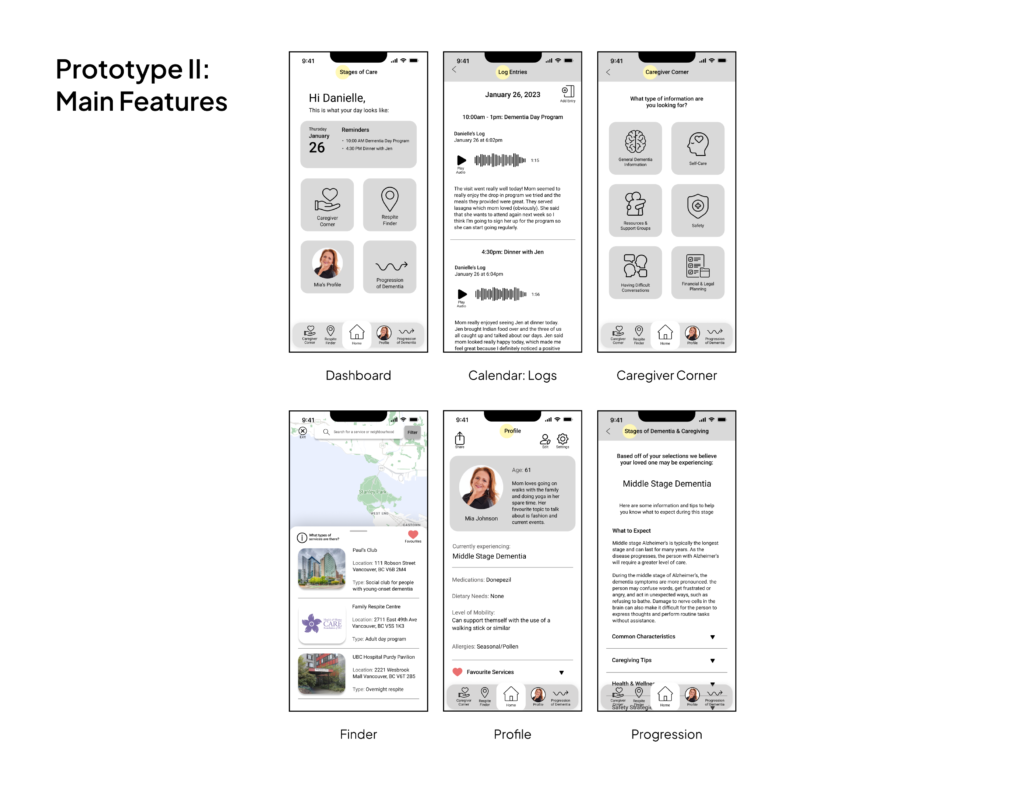
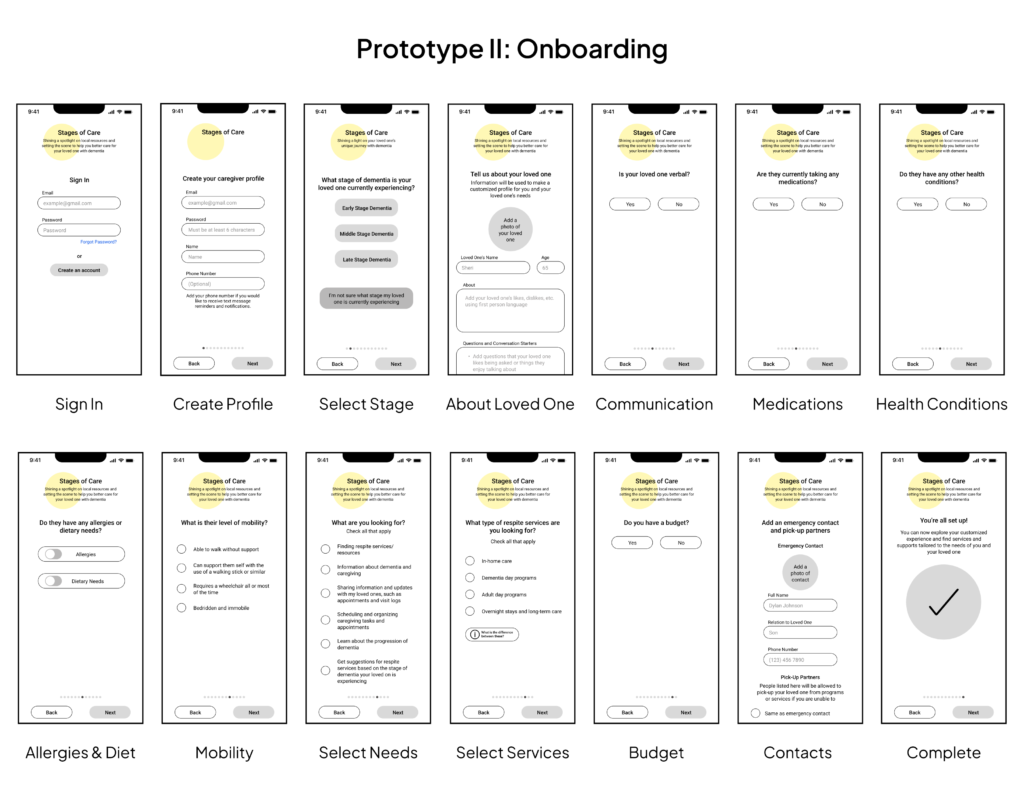
For this round of testing, I received feedback from my project mentor, caregiver consultant, classmates and instructor. Most of the feedback was related to adding additional sections and information about the person with dementia during onboarding and improving the UI and branding. The additional information about the person with dementia will help to better inform staff and other care partners about the person’s specific needs and will help to improve their care by people who may not know their needs as well as their primary caregiver. I also included links to the Alzheimer Society and safety information, such as emergency contacts and people who are allowed to pick up the person from programs and services. The UI and branding feedback that I received helped me to finalize my colour choices and the sun related imagery I chose to include.
Respite List
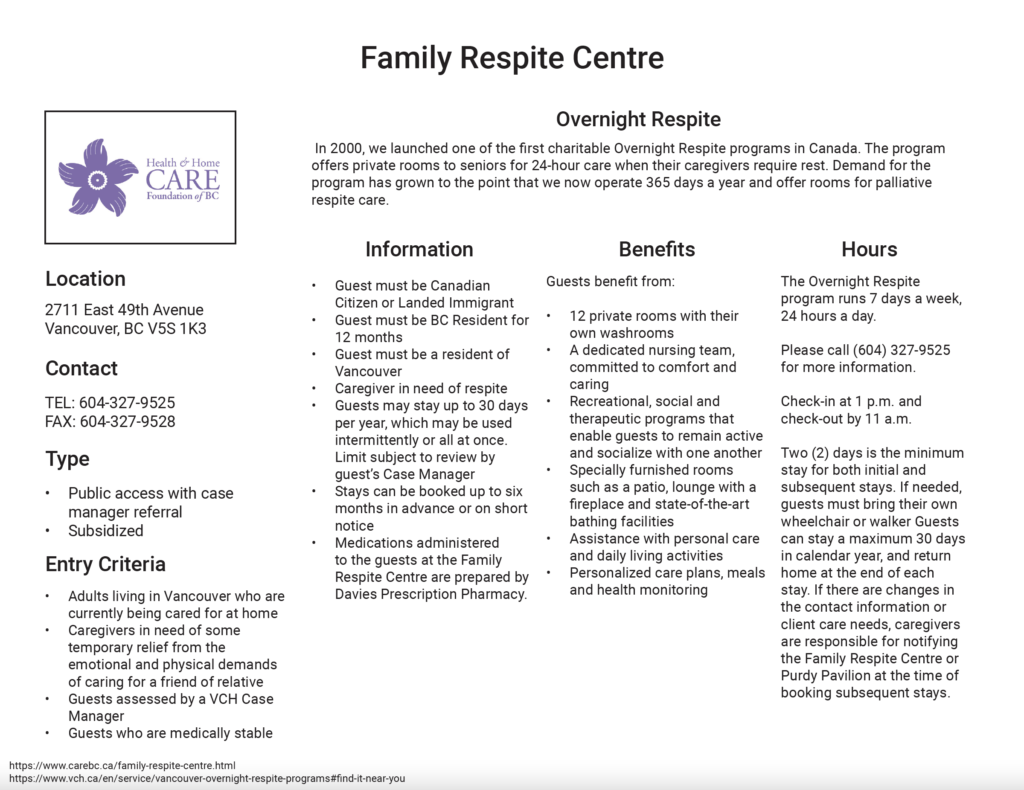
This is a page from my respite services document. A large part of this project in the beginning was collecting a list of local dementia respite services in Vancouver that caregivers could access. However, gathering the list proved to be more difficult that I thought. Initially, I thought there may be a short list of some of the main services floating around online or among service providers or case workers. However, after speaking to the Alzheimer Society, community day program staff, and getting feedback from a case worker I learned that no list currently exists. I have collected 7 services so far, and have a few more I would like to add to the list, but due to time constraints I was not able to update my list of services before the project was due.
Deliverables
Prototype III
These are some of the main screens of the third prototype with completed UI and branding. The features include a dashboard with customizable widgets, calendar to keep track of appointments and record things that happened each day, guidance section that includes information and advice about caregiving and self-care, finder to search for nearby respite services, learn about them and plan how to get there, profile that contains personal and health information about the person living with dementia, and progression section that includes information about the stages of dementia and advice on how to navigate each stage. Sharing information and news with loved ones, care partners and program staff can be important to keep everyone on the same page and aware of important health information. For this reason, parts of the profile and calendar sections are shareable.
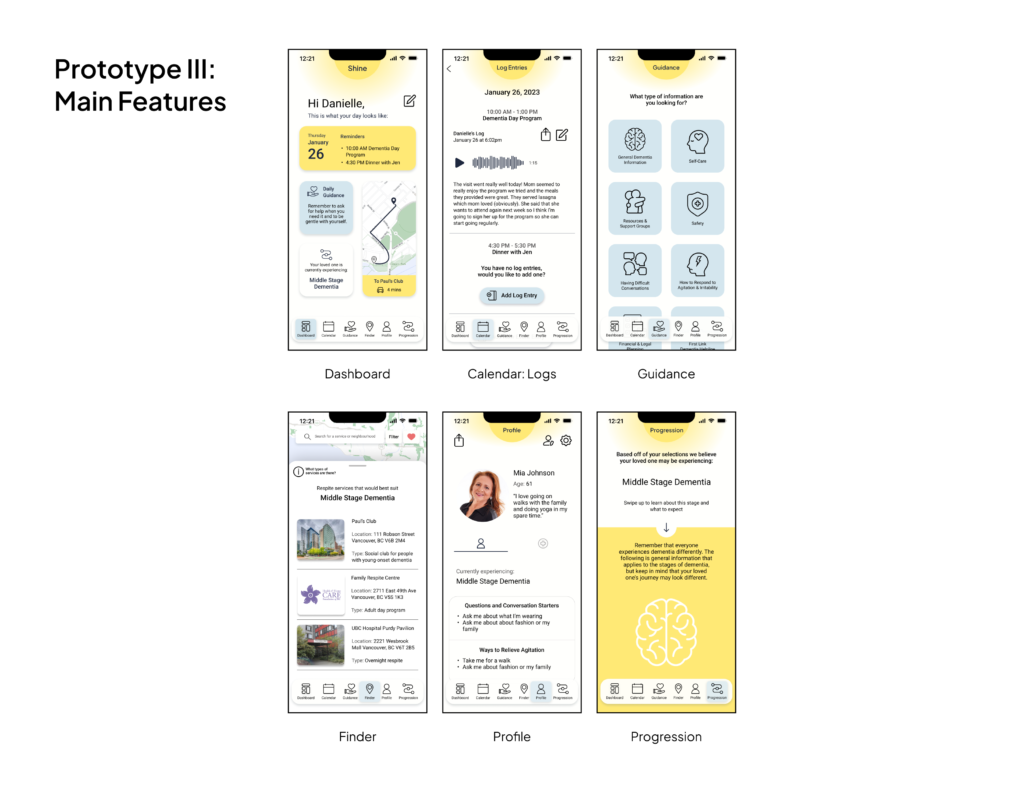
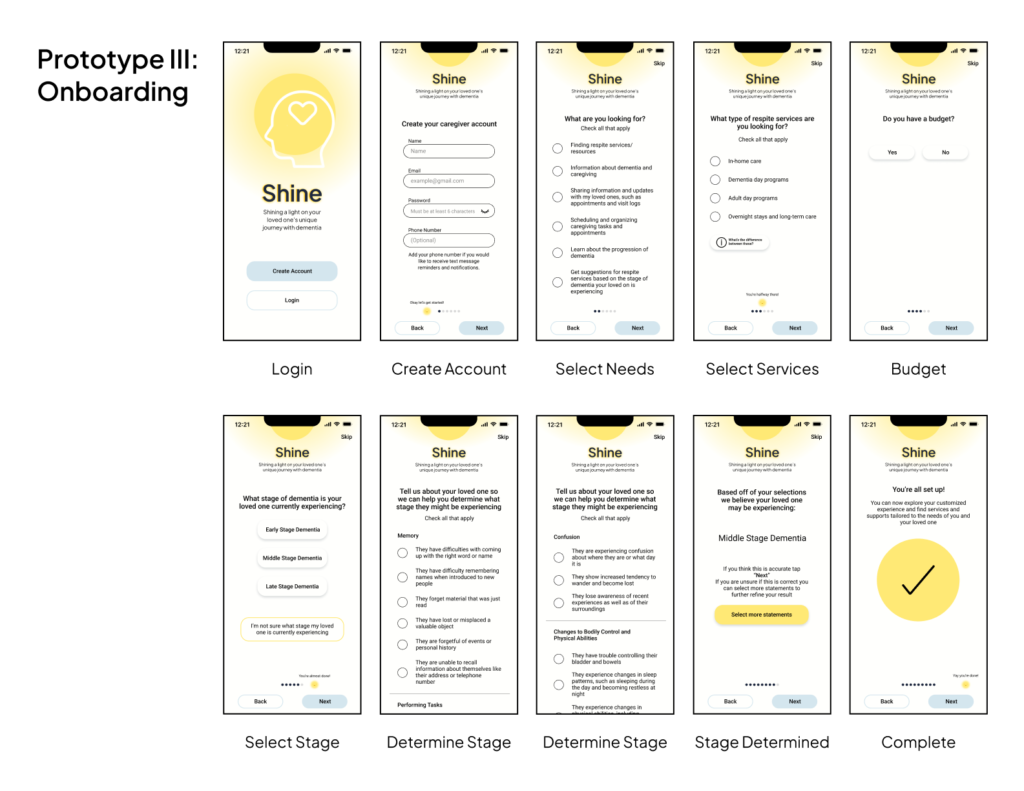
As I began to add more detailed onboarding questions, the process became quite long. For this reason, I chose to split it up into onboarding questions and profile questions. The profile questions can be completed anytime once a caregiver has entered the app, and are used to save personal and medical information of the person living with dementia.
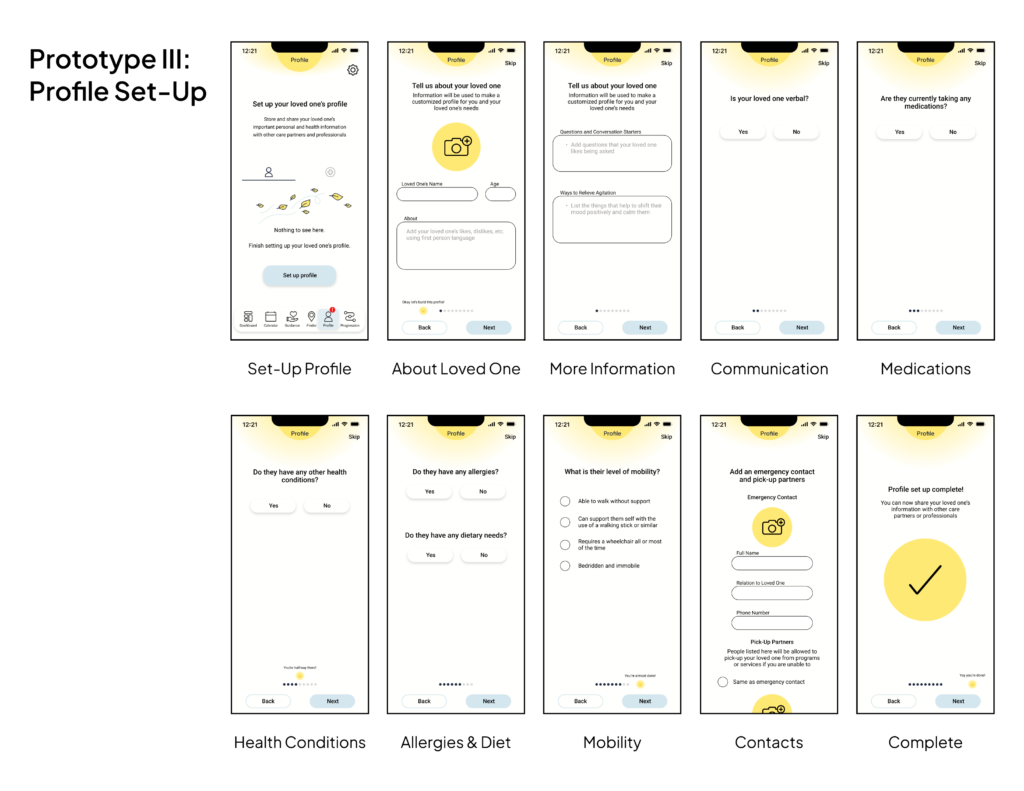
Micro Interaction
Since the app’s name is Shine, I wanted to play with sun imagery. I thought it would be an interesting feature if the sun at the top of the app moved across the top of the screen as time passed. During the night, the app will switch to a night colour scheme that uses a full moon instead of a sun. Click on the video to play.
Clickable MVP
This is my clickable MVP featuring two user flows. Flow 1 is a day in the life of a caregiver who already uses the app, and Flow 2 features the first use of the app and creating an account. Click through the Figma prototype to explore the two user flows.
Promo Video
This is Shine’s promo video. The video features Ray (Shine’s mascot) introducing Shine and giving the audience a tour of the app. The project persona is also present in the video. She can be seen completing the onboarding process, opening the Finder, and looking through her mom’s profile. The video was made with still images designed in Figma and live video recordings. Ray’s mouth movements were animated by using four still images cut together in different combinations. All of the animations, footage, and audio were edited together using Premiere Pro. Click on the video to play.
Future Steps
My future steps for this project are:
- Designing more of the app’s screens and filling out more content
- Adding a feature to create and save a care plan
- Adding HandyDart information and/or integration
- User testing prototype III
- Refining the UI and adding more micro interactions
- Expanding the list of respite services and adding them to the app
- Editing the wording of certain sections to give the app a more positive tone
Reflection & Thank You

This project came with its fair share of twists and turns, but overall I’m proud of the final result and I’m happy that I chose this topic. Working on this project gave me the opportunity to work and connect with many knowledgeable and generous people in the community. I would like to especially thank my project mentor and caregiver consultant for all of their knowledge, advice, and time. I have been very lucky to be able to work with these individuals, because they have always been very detailed in their feedback and willing to help me in any way they can. This project is much better informed because of their guidance and feedback. I would also like to thank my friend who acted as my persona Danielle in the promo video. She has helped me with the majority of my prototype videos throughout my time at Emily Carr, and I’m thankful for all of her time, patience, and willingness to always help me while also giving an A+ performance.
This project began as an app to locate and learn about respite services for people living with dementia in the Vancouver area. Collecting the list of respite services proved to be much more difficult than I initially expected, even with consulting professionals working in the dementia space. During my early interviews with staff at respite programs and caregivers, I was told that having a list like this would be valuable. Hearing this feedback and realizing how difficult it was to find respite services without the guidance of a professional or someone in the know, only reinforced my thoughts that having an accessible list of services would be useful to many caregivers. Most publicly funded programs need a referral from a case worker or healthcare professional, and sometimes require caregivers to wait up to a few months before their loved one is placed in a program. During this time, caregivers could experience burnout and adverse mental and physical health effects. This is why it is important for caregivers to know what all of their respite and care options are. There are private programs and those offered in the community that do not require a referral and can take clients immediately. However, finding these programs can be difficult as a lot of information is spread by word-of-mouth. In the future, I would be interested in exploring this further and continuing to build the list of services I’ve started.
While I am disappointed that I had to pause my search for respite services, I am also proud of what this project has developed into. It grew and became something much more well-rounded and tailored to each caregiver’s specific needs. Dementia affects each person differently, so being able to access information, services, and resources tailored to each person’s unique needs is valuable for caregivers. The final outcome is an app that I hope gives caregivers relief, support, and an optimistic outlook on their loved one’s diagnosis. Overall, I’ve really enjoyed working on this project this past year. I’m proud of the result, and thankful for all I have learned and everyone I met throughout this experience.
